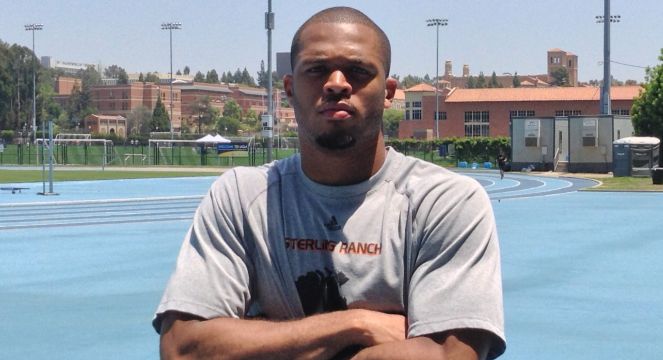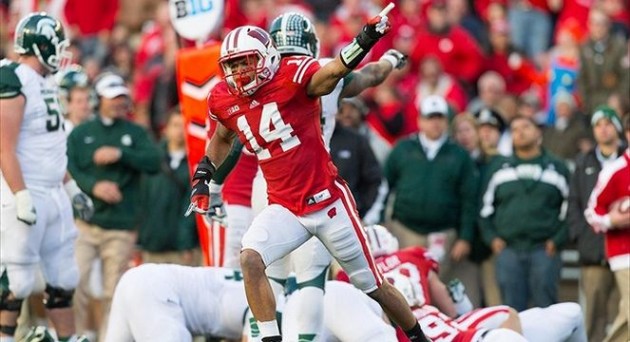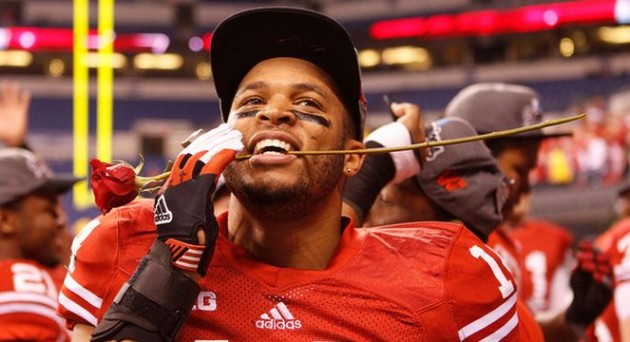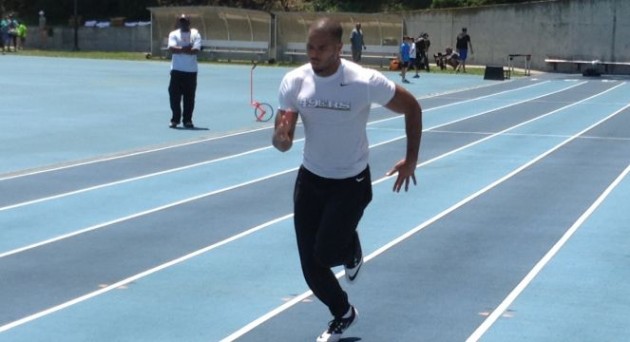Interview: Former Wisconsin CB Marcus Cromartie talks journey from high school to college and into the NFL

Written by Ryan Wright
There is not a sports story that has not been told and retold year after year, and day after day. One of two things typically happen either the rise and fall of greatness or the individual that persists forward regardless of the circumstances capturing the heart and imagination of those around him or her.
No matter how many players transcend to the next level of their given sport each journey remains unique and each story is worth hearing. The same holds true for former Wisconsin cornerback Marcus Cromartie. Marcus’ tale is one of constantly defying the odds placed against him at every turn only to see him succeed through self determination, perseverance, and God given athleticism.
Early in his high school career at Ben Franklin in New Orleans, Marcus was forced to move after one of the biggest natural disasters ever in U.S. history ravaged the gulf coast area of the country. Hurricane Katrina made landfall in August of 2005 racking up an estimated $108 billion in damages and was held accountable for the deaths of over 1,800 souls. When the Category 5 hurricane passed many people, including Marcus, were forced to move.
Marcus ended up at Timberview High School in Mansfield, Texas. Starting anew, he worked his way into becoming a 3-star cornerback earning five scholarship offers as part of the 2008 recruiting class. Kansas, Iowa State, Air Force, and Texas A&M all dropped offers but Wisconsin landed the then roughly 6’0”, 165 pound, raw athlete with 4.4 speed.
Life did not necessarily get any easier for Cromartie once he stepped foot on the Madison campus. He redshirted in 2008 and then toiled on special teams units as a freshman and sophomore until an opportunity came his way during his junior season. Devin Smith, a senior, suffered a broken foot in Week 2 of the 2011 season against Oregon State paving the way for Marcus to grasp a starting spot with the Badgers.
One might think the story turns up roses from there, all hail the conquering hero… not quite. After Wisconsin completed a 10-3 season with a ranking as high as No. 4 in the nation but finishing No. 9 in the AP after a 45-38 Rose Bowl loss to Oregon, Cromartie seemingly did not have the backing of then head coach Bret Bielema.
The 2011 squad was absolutely loaded with talent that included quarterback Russell Wilson, running backs Montee Ball, Melvin Gordon, and James White, linebackers Chris Borland and Mike Taylor, guard Kevin Zeitler, center Peter Konz, tackle Rick Wagner, receiver, Nick Toon, and fullback Bradie Ewing. Yet a then 41-year-old head coach in his sixth season as head coach laid a lot of weight on Marcus’ shoulders after the loss of Devin Smith for the season.
Even in his own words, Marcus was evolving into his role as a cornerback but took the field in 2012 as a starter routinely lining up against some of the top receivers in the collegiate game. At the end of his senior year he had 62 tackles, led the Big Ten in pass breakups, and saved his best for last coming up with seven tackles, a pick-six, and two pass breakups against Nebraska in the Big Ten Championship Game pushing an 8-5 team into the Rose Bowl for a third straight year to face No. 8 Stanford, a game the Badgers would lose 20-14.
The path forward still was not an easy one for Marcus. Come the 2013 NFL Combine he was shunned left with no option but to show out during his pro day, which he did. He posted a 4.35 forty-yard dash putting him on par with the best of the best in that year’s draft. Despite the two-years of game film the NFL passed on Marcus in the draft, but to be fair only two Big Ten cornerbacks were drafted that year, Terry Hawthorne ( Fifth Round – No. 150) out of Illinois and Micah Hyde (Fifth Round – No. 159) out of Iowa.
The San Diego Chargers signed Marcus to a free agent deal for the 2013 season. He then got a chance with the Cleveland Browns in October of 2014 and then latched on with the San Francisco 49ers in November of the same year.
This year Marcus looks to do what he always does, find a way to succeed through quiet determination and the self confidence within that has helped him overcome far more than most on a parallel journey.
In a Recruiting News Guru exclusive interview I caught up with Marcus after a speed training workout with Coach Chris Asher in preparation for the San Francisco 49ers training camp. During the interview we covered his high school and college career while getting an insight on words of wisdom to pass down to college and high school players setting off on their own hopefully journey to collegiate stardom and a chance to play in the league.
Marcus, at what point did you know you were an exceptional athlete?
“I was always an exceptional athlete I actually started as a freshman in high school and then in my sophomore year in high school I was displaced because of Hurricane Katrina to Dallas. That forced me to take a year off from football. I came back for my junior and senior year. I was always an exceptional athlete but I was never crafted into my position, I was just always really fast and quick. I never had honed my craft down as a cornerback until I got to college.”
Did you play both ways in high school? Did you play any wide receiver and cornerback?
“I didn’t play wide receiver but I handled all the kick return duties. I was the kick returner and the punt returner. They wanted to get the ball into my hands as much as possible but I had a lot of other good players on my team too. They didn’t quite need me on both sides of the ball. But I was definitely explosive every time I touched the ball.”
What was your height and weight during your sophomore/junior year?
“I was probably about the same height, about 6-foot, but I weighed about a buck-60 man (160 pounds). I actually went to college at about a buck-65. I tell people don’t worry so much about your weight worry about your speed. The weight will come but you can’t get much faster but you can get a lot stronger.”
Do you remember what you were running in the 40-yard dash in high school from your sophomore season to your senior season?
“Yeah, I got lucky I was connected with a track coach when I got to Texas. He took me in and told me, “Look, I know you play football but you need to run track.” He made me a lot faster. I was probably running a 4.7 in my first year in high school and I know I left high school running a 4.4. It is just something that I credit to track and track workouts because it helps you run all year. Football in the fall and track during the spring, it keeps you active throughout the whole year and helps you build that muscle endurance and your speed ultimately.”
When you went off to Wisconsin, how did that come about? Was Wisconsin recruiting you heavily or were the Badgers a program you were more interested in because of their success on the field?
“They were one of the first schools that started recruiting me. Texas A&M, Florida, and Kansas all came after Wisconsin. I felt like this school saw me before a lot of these other schools saw me and they were the program that I had talked to the longest and felt the most comfortable with. I kind of took a shot in the dark and choose Wisconsin. It ultimately worked out for the best.”
From your perspective looking back, what would you advise kids to do because you’ve been down the recruiting path? Would there be anything different that you would look at when going down your checklist before verbally committing to a given program?
“I’d tell them to take their time. A lot of times coaches can be manipulative. They can say things like, “Well if you don’t commit now we might not have a scholarship for you on signing day.” If they really want you they’ll make sure they have a scholarship for you. I encourage kids to take all of their visits. Take all five. Unfortunately I only took three. I wish I would have taken the other two. It’s something that I tell kids, “don’t be in a hurry to choose a school. You have until February, wait until February.”
Besides Wisconsin, what were the other two schools you took official visits to your senior year?
“I took visits to Kansas, which at the time was coming off an Orange Bowl win. Obviously right now they are not playing great football but when I was getting recruited by them they had two 10-win teams a cornerback named Aqib Talib and a guy named Chris Harris at corner, two Pro Bowlers. That was my No. 2 choice. I took an unofficial to Texas A&M and an official to Iowa State. I had a couple of Big 12 offers but I choose to go to the Big Ten.”
What was it about Wisconsin that drew you there? I know you had a good relationship with the coaches but did they have a good pitch? What did you really like that they were selling as a recruit?
“At the time they were a consistent 10-win team. They were a team that was going to compete for a Big Ten championship every year. As it happened we won three when I got there. It was something they recruited me on, “You come here and we’ll win a Big Ten title and go to the Rose Bowl.” That was something that struck me. When you think of the Rose Bowl that is one of the most historical bowl games you can go to.
“I went there and felt so comfortable with the players that were already there. It was a good feeling and I felt good about the school.”
From your high school days into your college days, you were 165 pounds going into college. At what point did your body start to mature and you saw that jump physically in strength and started to add weight?
“I think I am still coming physically into my own to be honest with you. I think every year I see strides in my body that I didn’t see before. I think that is just a credit to – I think everybody’s body is different. You have to find out where you have to work harder at to offset the parts of your body that might not need as much development. I know for me I always needed to gain weight and build upper body strength. My lower body was fine, my speed was there.
“I think some people need to do that extra rep or that extra workout. I think you need to find out on your own that your body and the next guy’s body are not the same. You need to see where you need to grow. I think that is really important for kids to understand. Not where my friend or teammate needs to get better but where I need to get better for myself.”
What was your early history of playing time at Wisconsin? Did you see time on special teams and then work your way into the role of a starter by your junior season?
“It is always an adjustment when you go from high school to college. You go to college and they put you on scout team, I was never used to being a Look Team guy. In high school I was always either the starter or the next guy up, or something like that. I never had to be on the scout team. I think that takes a maturation process to understand that you can get better being a Look Player. You can get better being a third or fourth string guy. At the time, being a freshman and sophomore, I never saw it that way. I kind of took that period off because I never saw scout team as being a role where you could get better.
“In the NFL you have to adjust quickly because the reps are limited. You have to get in where you fit in. It took me a while to understand college ain’t like high school. You can’t progress as a team you have to progress on your own. You have to show out. You have to separate yourself. That took me a while to understand.”
What were some of the other adjustments you had to make as a young man going far away from home, from an academic, maturation, and football standpoint?
“I think you have to understand finances as well. When you go to college and you get a scholarship and they give you a set amount of money you have to learn how to balance that out for the month. You have a roommate but you have to understand if you get $1,200 a month and $600 is going toward rent you have to make sure the other $600 is lasting you the rest of the month to cover any other expenses. You have to understand that. You don’t necessarily have parents to lean on coming from where they were paying the rent, the electricity, and the cable bill. Now you have to start paying these bills.
“You have to learn how to balance out your time and your finances and the reason you are there is to play football.”
Going into your junior year when you became a starter what changed for you from your sophomore year when you did not start? Did the light bulb go off and you figured it out, did you take a big jump physically, or were you the next guy up? What changed for you between those two seasons where you became an important piece to a major Big Ten program?
“I think it was partly confidence. A lot of times people don’t make the plays that they could because they lack confidence and belief in themselves to make those plays. You have to instill in yourself the confidence that I am going to go out here and be the best. I don’t think it was so much one summer I thought I need to make that jump. Every summer I was thinking I need to start but it is one thing to say it but it is another thing to do it.”
I’ve got to rib you a little here. Your junior year you had 47 tackles and your senior year you had 62 tackles but you only had one career interception. How did someone with your speed and abilities only get one career interception in college?
“Yeah, that’s right. It’s funny that you said that but the one interception I took back for a touchdown in the Big Ten Championship Game. I guess you can say I got it when it counted.
“An interception can be a tall tale because, especially playing in the Big Ten where the other team might only throw the ball 10 times a game. We played a lot of power running football teams. Ohio State ran the Power Option and played teams like Michigan State who had Le’Veon Bell who ran the ball some 35 times a game. If you play against teams like in the Pac-12 and the SEC where they throw the ball 40 times a game you have more opportunities. You still have to be opportunistic. I still had 12 pass breakups, I was tops in the Big Ten with that. I wish I would have gotten more picks I would have been drafted higher.”
By the time you left college and were entering the NFL Draft what were your measurables? What was your height and weight?
“I was 6’.5”, and about 198. I ran a 4.35 during my pro day. I shuttled like a 4.0. I bench pressed about 14 times (225 pounds). I had all the measurables. I feel like you put my measurables against anyone out there at the combine and I am right there with them. San Diego saw that when they signed me. They saw a player that had it but just needed to hone his skills and I’m still doing that. I always find something I can get better at. That is what will make me a Pro Bowl player I believe.”
What are some of the things you do today with workouts and with your training to improve your cover skills on the field?
“I’m a fan of the game first. I think everybody who plays in the NFL at one point was a fan of the game. I look at the players who have been in the Pro Bowl. I look to see what they are doing and see what I can take away from that to improve my game. I’ll never be too proud to look at somebody else to see what they are doing, even if it’s a college player. If a college player is playing great I’m critiquing him where I can see myself. I’m always studying film trying to get better.”
One more question about your college days. Playing against teams in the Big Ten, was there a team or a couple of teams you looked forward to playing every year?
“I always knew it was going to be a good matchup when we played Michigan State. That was kind of our rival when I was there. They had Kirk Cousins and Bell, and a great defense with a couple of first rounders. I always looked forward to playing Michigan State because I knew it was going to be a dogfight. I knew it was going to come down to one or two plays and it always did.”
In college was there a wide receiver you always looked forward to going up against for the challenge?
“You know, I never had one guy where it just became a battle. I felt like, especially my senior year, it got to a point where I was playing against a decent receiver every week. My senior year I played against Markus Wheaton and Brandin Cook from Oregon State and Devin Smith from Ohio State and then I played Keshawn Martin from Ohio State.
“It got to a point where I was playing some talented players every week. It never got to the point where I was like “oh well this will be an easy week this week.” And there was the guy from Indiana that played for the Broncos, Cody Latimer. I always played against somebody every week that you had to come ready.”
You talked about from a learning standpoint looking at those guys that came before you. From a training standpoint where are you doing day in and day out to prepare for a NFL season?
“The most important thing is staying healthy in any sport, basketball, baseball, or football. They always say you can’t make the team in the training room. You can’t make the team if you’re hurt. I always take care of my body. I do a lot of stretching. I drink a lot of water. I roll on my body every night. Taking care of your body short term will help you long term. You have to take of yourself everyday. You can’t hop in the cold pool once a week or I’m only going to stretch once a week. You have to do that even when you’re not working out. You have to do it everyday and do it consistently.”
Marcus, thank you.
“No problem.”
Photo credit: ninerfans.com; Marcus Cromartie with Wisconsin.
Photo credit: fansided.com; Marcus against Michigan State (2012).



